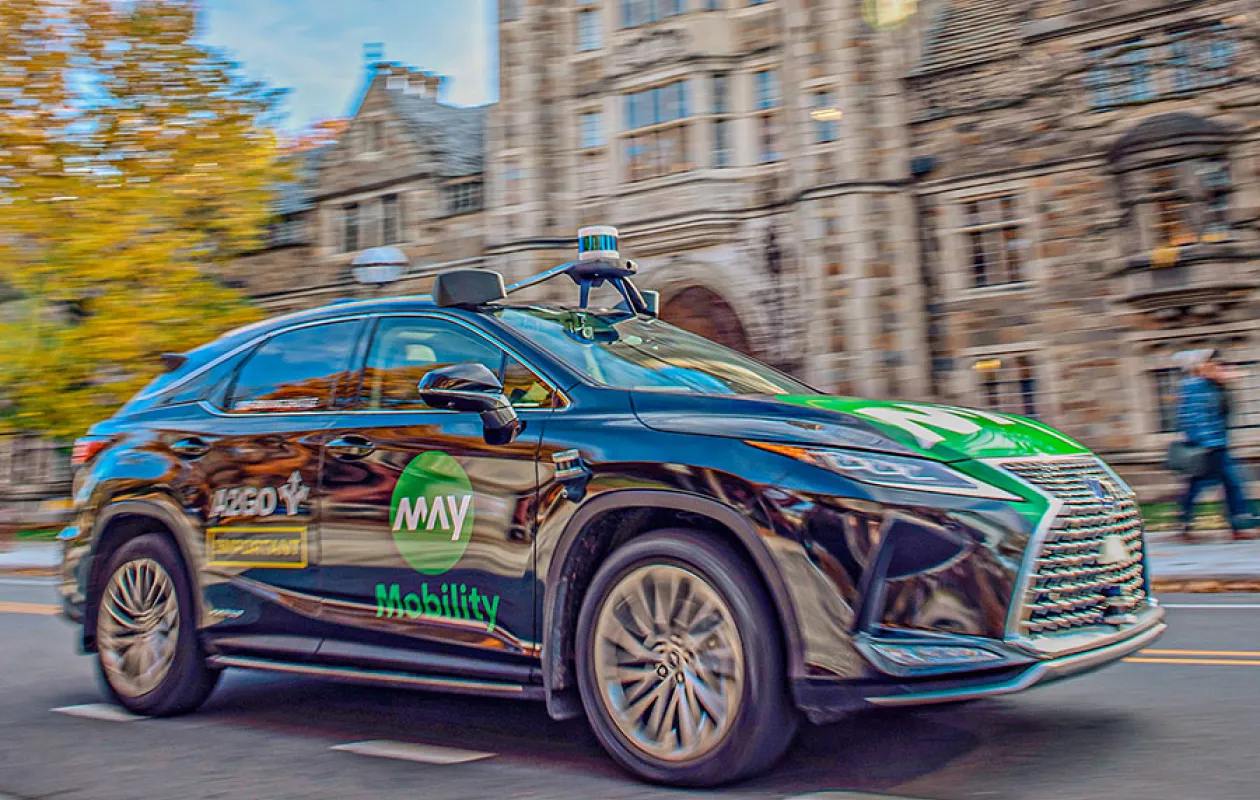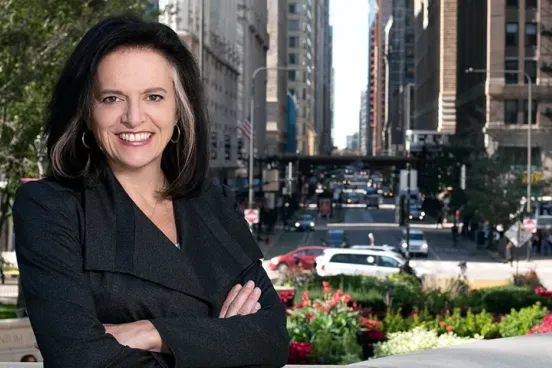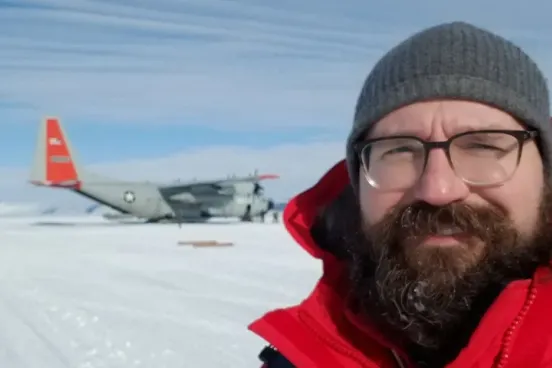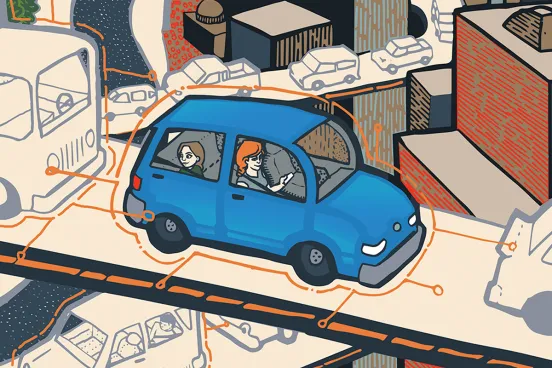In June 2018, a boxy vehicle rolled onto the University of Michigan’s North Campus Research Complex.
Although it could have been mistaken for a run-of-the-mill shuttle running a mundane route around the complex, one detail set it apart from the average bus: the lack of a driver. The autonomous vehicle (AV) was part of a pilot program operated by Mcity, U-M’s center for research related to the future of transportation and mobility.
The pilot was the first of its kind in the country, because rather than technical research, the study was focused on how humans would react to interacting with and riding in an automated vehicle, including passengers, drivers in other vehicles, pedestrians, and other road users.
By moving beyond technical questions to broader social issues—exploring what it means to share the world with machines that can act independently from humans—the pilot program represented an important shift in AV testing.
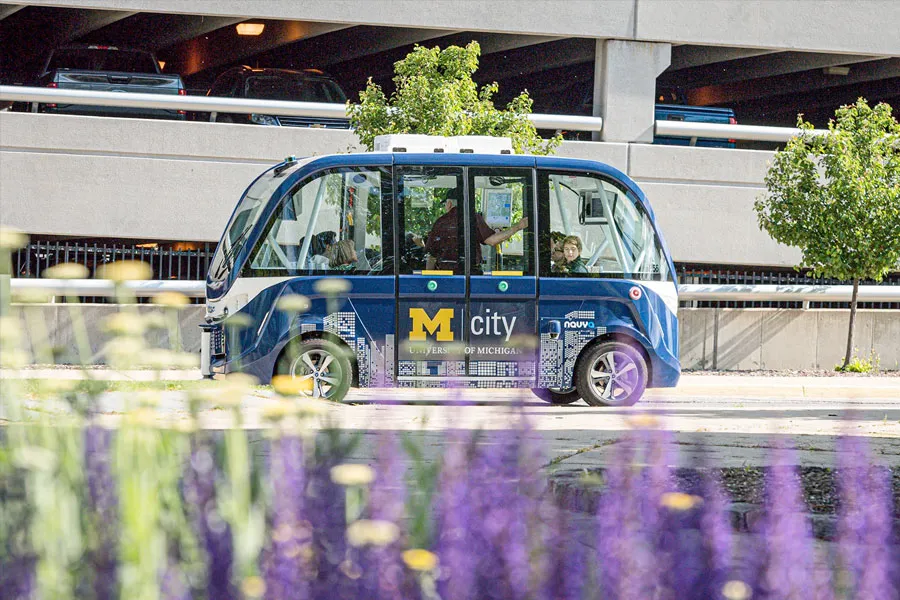
AVs like the Mcity shuttle are just one of the many emerging transportation technologies that promise to change more than just who, or what, is driving your car. From the proliferation of electric scooters in many cities, including Ann Arbor, to automated delivery robots rolling down sidewalks and delivery drones zipping overhead, the new mobility revolution is generating novel ways to move people and goods. Emerging mobility technologies promise to reduce traffic deaths, increase access to transportation for the elderly and people with disabilities, and revolutionize how we move through the world.
Integrating new mobility technologies into our transportation system isn’t just a technical challenge. It also presents new legal and regulatory questions, none of which have simple solutions. And just as Mcity has put the University at the forefront of the technological side of this revolution, faculty, staff, students, and alumni of Michigan Law are working on the cutting edge of this exciting new area of law.
Issues of First Impression
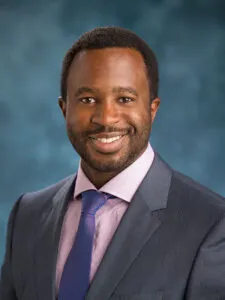
Before the Mcity shuttle could make its debut, the University had to know if it was legal to operate an AV in public. With a potentially historic project on the line, the University called on a diverse team of experts to ensure the program could move forward, including C. Ndu Ozor, ’09, associate general counsel at U-M. “The process for approval was completely novel because the University had not previously launched a project of this kind,” he recalls. “Risk Management was in the room; the University’s vice president of research, a number of attorneys, various faculty with expertise in the AV, robotics, or engineering space were present.”
While the pilot program was in its planning stages, Michigan state legislators were in the process of writing updated AV laws. The University’s Office of Government Relations successfully collaborated with lawmakers to clarify language governing research centers, paving the way for the project to move forward. “We thought the language provided the University enough protection for the purposes of having a shuttle launch on roads open to the public,” he says. “There were a few nuances that had to be addressed to make it work, but we got a number of stakeholders involved, including the National Highway Traffic Safety Administration (NHTSA).”
The team conducted internal research and hired outside counsel. Moreover, they brought the NHTSA to Ann Arbor to simulate the process and protocols in the event of an accident. The pilot program ultimately cleared the technical and regulatory hurdles and went ahead, providing researchers with actionable data related to how people respond to driverless vehicles—one of the many examples of U-M leading the charge in mobility.
The State of the Law
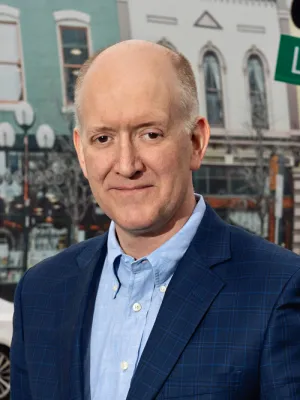
After more than a century of automobiles, two centuries of railroads, and centuries more of maritime traditions, there are well-established laws and customs governing how we move about the world. Federal regulations dictate the safety of our cars and their emissions, and federal money helps fund our highways and mass transit systems. States regulate who can drive and require things like license plates to dictate what vehicles can be on the road, while also setting most traffic laws. Local governments also have a hand in traffic and parking rules and often operate local public transit networks. The system is fragmented and complex and was not set up to accommodate new technology like driverless vehicles.
One issue is that AVs and other new mobility technologies often exist outside of established legal categories and definitions. For example, the federal government’s main tool for regulating the design of motor vehicles, the Federal Motor Vehicle Safety Standards (FMVSS), requires vehicles to have human-centered controls like steering wheels and brake paddles, which may not be required on certain AVs. Likewise, many state laws reference “drivers” throughout their traffic laws, codifying a required human element.
Some of these issues have been solved at the state level; more than 30 states, including Michigan, have passed laws that allow for AV testing and deployment in some capacity. A common solution is to add “automated driving system” (ADS) or a similar term into the relevant laws, enabling legal alternatives to human drivers under certain conditions. In Michigan, for example, a 2016 law defined ADS as “hardware and software that are collectively capable of performing all aspects of the dynamic driving task for a vehicle on a part-time or full-time basis without any supervision by a human operator.”
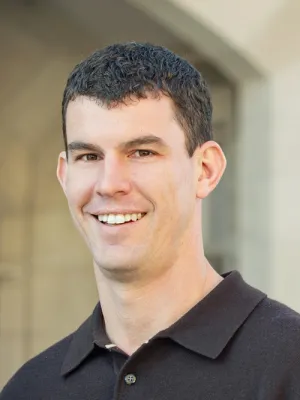
Whether the next phase of AV regulation comes at the state or federal level is among the most consequential questions facing the industry. Within the United States, the car, as a technology, has been primarily regulated at the federal level. But the driver, as a person, has been primarily regulated by the states. “For now, there’s still a big question that I don’t see being answered anytime soon, which is ultimately who is going to decide these big policy and legal questions, and whether it will be the states or the federal government,“ says Dan Crane, Michigan Law’s Frederick Paul Furth Sr. Professor of Law. “And that’s one of the things that the Law School and U-M can bring to the table in this area, is to convene stakeholders through conferences and our journals and to make these important conversations happen in ways that might not happen organically.”
Legislation to modify existing motor vehicle regulations at the federal level has been proposed almost yearly, but efforts have been unsuccessful to date. Initiatives at the state level have helped with testing and development, but in terms of wide-scale adoption of AVs, remain a stopgap measure without federal guidance. “Unsurprisingly, the gridlock in Congress stalled the push for federal legislation. Part of this delay is because the technology itself has not been ready for full deployment,“ says Ozor. “I think of it as a sort of tipping bucket and that once the technology advances materially there’s going to be renewed emphasis on making sure we have appropriate legislation. There’s a significant amount of work yet to be done because if you look at the current legislation in place across differing states, the variability is extremely problematic.”
Without congressional direction, agencies like the NHTSA are left to regulate the industry with limited tools. One tool is the ability to grant exemptions to the FMVSS; however, this process is not a silver bullet. “There is an exemption that’s pretty small, currently around 2,500 vehicles, that allows vehicles to be deployed that don’t meet safety standards,” explains Bryce Pilz, ’00, executive director of licensing and strategic alliances for U-M Innovation Partnerships, which helps commercialize ideas that emerge from University research. “But it’s not enough for a company to commercially deploy in a profitable way,” Pilz adds, illustrating one of the barriers to the AV industry’s future growth.
Other Legal Issues
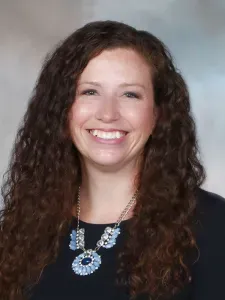
The early days of the AV industry were filled with bold proclamations of the imminent automation of our roadways. But expectations have been tempered in recent years, and the introduction of autonomous driving technology has proven to be more complex and drawn out than many expected.
“Part of my understanding earlier on had been that the AV was a binary concept in which you went from having a human driving a car to a car that just drove itself,” says Crane. “As more technology has come toward the market, with different degrees of automation, it’s clear we’re not going whole hog right away. And what that means is that the challenge for law and regulation is even greater than we started with.”
Some legal issues, like liability—once seen as a major obstacle for AVs, and one of the issues commonly cited as a barrier to federal legislation—no longer seem as intractable. “I think we have largely moved on from the early assumption that liability would be a significant impediment to the deployment of AVs and are focused on more pressing issues, such as creating a regulatory framework that will allow deployment of AVs at significant volumes,” says Emily Frascaroli, who teaches a class on AVs and the law at Michigan Law, and is managing counsel of the product litigation group for Ford Motor Company (she also holds a U-M master of engineering degree).
Pilz, intimately familiar with the novel challenges that arise when advising technology startups, notes that the mobility space regularly raises new issues and that it’s up to companies and regulators to address them as they come up. “There’s some open-ended questions, there’s going to be some very novel questions out there. But they’ll be sorted out; people will be able to price that into their business models and find some way to insure against it.”
Mobility in the Law Quad
Michigan Law launched its Law and Mobility Program in 2018. The program is a partnership with Mcity and the State of Michigan and is a unique effort to build discussion around the legal aspects of emerging transportation technologies. Based in Ann Arbor, the program is co-directed by Crane and Professor Bryant Walker Smith of the University of South Carolina School of Law, who has been one of the leading experts on the AV industry since its infancy. The program is run as a partnership between the schools and is overseen by an Ann Arbor-based fellow who runs its day-to-day affairs and works with students from both schools. The program publishes the Journal of Law and Mobility, the only legal journal in the nation that is dedicated to emerging transportation technology. For Crane, the journal’s success comes from attracting authors from different fields who can create “cutting-edge analysis and reflection on the set of legal and regulatory questions around this mobility revolution itself.”
For the last five years, Michigan Law students have been able to take a class on AVs and the law, taught by Frascaroli, who in addition to her position with Ford sits on the Michigan Council on Future Mobility and Electrification and is a member of the Journal of Law and Mobility’s editorial board. During that time, Frascaroli has noticed a change in what topics most interest students. “My students have always been interested in the technology,” she says. “In the early years, there was a focus on safety, regulation, and privacy. Over time, I have seen a shift to more interest in current social topics, such as accessibility, racial equity, and the environment.” The class not only discusses the legal and regulatory structures around AVs but also requires students to take on roles within an AV crash scenario. While the class has to keep up with an ever-changing AV landscape, Frascaroli notes that “one thing hasn’t changed at all—people are fascinated by and excited about the technology and the freedom of movement that it promises.”
The Law and Mobility Program hosts an annual gathering to discuss the developments in the industry, and its 2021 online conference, “Brave New Road: The Role of Technology in Achieving Safe and Just Transport Systems,” brought together experts from academia, industry, government, and advocacy to discuss equity and civil rights issues related to emerging transportation technologies. It was the third annual event, following “(Re)Writing the Rules of the Road” in 2019, which dealt with more basic questions of AV regulation, and the 2020 conference, “Global Perspectives on Law, Policy, and Mobility Innovation,” which brought guests in from around the world to learn more about the transportation needs of middle-income and developing nations.
The Future is Now
As Michigan Law’s mobility-focused work continues, Ann Arbor’s streets are fast becoming a hub for a number of new mobility technologies, including bike-sized delivery robots from Ann Arbor-based Refraction AI, seen around town delivering Zingerman’s sandwiches. In October 2021, Mcity partnered with May Mobility to launch A2Go, a fleet of autonomous on-demand taxis that serve a portion of Ann Arbor that includes Kerrytown, Central and North Campus, and the State Street corridor. If Michigan Law students want a free-of-charge ride to and from class in an autonomous vehicle, all they need to do is download an app on their smartphone and request a ride, à la Lyft or Uber. At Michigan Law and in Ann Arbor—not to mention the rest of the country and the world—it’s an exciting time to shape the future of mobility.
Ian Williams, ’18, was the inaugural Law and Mobility Fellow at Michigan Law from 2018 to 2021 and is now an associate with Venable LLP in its Washington, D.C., office, where he works in the autonomous and connected mobility group. In the interest of full disclosure, the University of Michigan, Ford Motor Company, and Lyft are all clients of Venable.


